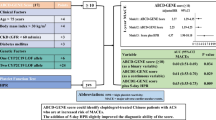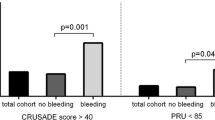Abstract
Background
Various genetic and nongenetic variables influence the high on-treatment platelet reactivity (HTPR) in patients taking clopidogrel.
Aim
This study aimed to develop a novel machine learning (ML) model to predict HTPR in Chinese patients after percutaneous coronary intervention (PCI).
Method
This cohort study collected information on 507 patients taking clopidogrel. Data were randomly divided into a training set (90%) and a testing set (10%). Nine candidate Machine learning (ML) models and multiple logistic regression (LR) analysis were developed on the training set. Their performance was assessed according to the area under the receiver operating characteristic curve, precision, recall, F1 score, and accuracy on the test set. Model interpretations were generated using importance scores by transforming model variables into scaled features and representing in radar plots. Finally, we established a prediction platform for the prediction of HTPR.
Results
A total of 461 patients (HTPR rate: 19.52%) were enrolled in building the prediction model for HTPR. The XGBoost model had an optimized performance, with an AUC of 0.82, a precision of 0.80, a recall of 0.44, an F1 score of 0.57, and an accuracy of 0.87, which was superior to those of LR. Furthermore, the XGBoost method identified 7 main predictive variables. To facilitate the application of the model, we established an XGBoost prediction platform consisting of 7 variables and all variables for the HTPR prediction.
Conclusion
A ML-based approach, such as XGBoost, showed optimum performance and might help predict HTPR on clopidogrel after PCI and guide clinical decision-making. Further validated studies will strengthen this finding.




Similar content being viewed by others
References
Valgimigli M, Bueno H, Byrne RA, et al. 2017 ESC focused update on dual antiplatelet therapy in coronary artery disease developed in collaboration with EACTS: the task force for dual antiplatelet therapy in coronary artery disease of the European Society of Cardiology (ESC) and of the European Association for Cardio-Thoracic Surgery (EACTS). Eur Heart J. 2018;39(3):213–60. https://doi.org/10.1093/eurheartj/ehx419.
Levine GN, Bates ER, Bittl JA, et al. 2016 ACC/AHA guideline focused update on duration of dual antiplatelet therapy in patients with coronary artery disease: a report of the american college of cardiology/American Heart Association task force on clinical practice guidelines: an update of the 2011 ACCF/AHA/SCAI Guideline for Percutaneous Coronary Intervention, 2011 ACCF/AHA Guideline for Coronary Artery Bypass Graft Surgery, 2012 ACC/AHA/ACP/AATS/PCNA/SCAI/STS Guideline for the Diagnosis and Management of Patients With Stable Ischemic Heart Disease, 2013 ACCF/AHA Guideline for the Management of ST-Elevation Myocardial Infarction, 2014 AHA/ACC guideline for the management of patients with Non-ST-elevation acute coronary Syndromes, and 2014 ACC/AHA Guideline on perioperative cardiovascular evaluation and management of patients undergoing noncardiac surgery. Circulation. 2016;134(10):e123-155. https://doi.org/10.1161/cir.0000000000000404.
Wang D, Yang XH, Zhang JD, et al. Compared efficacy of clopidogrel and ticagrelor in treating acute coronary syndrome: a meta-analysis. BMC Cardiovasc Disord. 2018;18(1):217. https://doi.org/10.1186/s12872-018-0948-4.
Claassens DMF, Bergmeijer TO, Vos GJA, et al. Clopidogrel versus ticagrelor or prasugrel after primary percutaneous coronary intervention according to CYP2C19 genotype: a popular genetics subanalysis. Circ Cardiovasc Interv. 2021;14(4):e009434. https://doi.org/10.1161/circinterventions.120.009434.
Fan W, Plent S, Prats J, et al. Trends in P2Y12 inhibitor use in patients referred for invasive evaluation of coronary artery disease in contemporary US practice. Am J Cardiol. 2016;117(9):1439–43. https://doi.org/10.1016/j.amjcard.2016.02.012.
Gurbel PA, Becker RC, Mann KG, et al. Platelet function monitoring in patients with coronary artery disease. J Am Coll Cardiol. 2007;50(19):1822–34. https://doi.org/10.1016/j.jacc.2007.07.051.
Capodanno D, Angiolillo DJ. Platelet monitoring for PCI: which test is the one to choose? Hamostaseologie. 2009;29(4):376–80.
Tantry US, Bonello L, Aradi D, et al. Consensus and update on the definition of on-treatment platelet reactivity to adenosine diphosphate associated with ischemia and bleeding. J Am Coll Cardiol. 2013;62(24):2261–73. https://doi.org/10.1016/j.jacc.2013.07.101.
Stone GW, Witzenbichler B, Weisz G, et al. Platelet reactivity and clinical outcomes after coronary artery implantation of drug-eluting stents (ADAPT-DES): a prospective multicentre registry study. Lancet. 2013;382(9892):614–23. https://doi.org/10.1016/s0140-6736(13)61170-8.
Aradi D, Gross L, Trenk D, et al. Platelet reactivity and clinical outcomes in acute coronary syndrome patients treated with prasugrel and clopidogrel: a pre-specified exploratory analysis from the TROPICAL-ACS trial. Eur Heart J. 2019;40(24):1942–51. https://doi.org/10.1093/eurheartj/ehz202.
Ignjatovic V, Pavlovic S, Miloradovic V, et al. Influence of different β-Blockers on platelet aggregation in patients with coronary artery disease on dual antiplatelet therapy. J Cardiovasc Pharmacol Ther. 2016;21(1):44–52. https://doi.org/10.1177/1074248415581175.
Janssen PWA, Bergmeijer TO, Vos GA, et al. Tailored P2Y(12) inhibitor treatment in patients undergoing non-urgent PCI-the popular risk score study. Eur J Clin Pharmacol. 2019;75(9):1201–10. https://doi.org/10.1007/s00228-019-02696-z.
Angiolillo DJ, Capodanno D, Danchin N, et al. Derivation, validation, and prognostic utility of a prediction rule for nonresponse to clopidogrel: the ABCD-GENE score. JACC Cardiovasc Interv. 2020;13(5):606–17. https://doi.org/10.1016/j.jcin.2020.01.226.
Hernandez-Suarez DF, Melin K, Marin-Maldonado F, et al. Implementing a pharmacogenetic-driven algorithm to guide dual antiplatelet therapy (DAPT) in Caribbean Hispanics: protocol for a non-randomised clinical trial. BMJ Open. 2020;10(8):e038936. https://doi.org/10.1136/bmjopen-2020-038936.
Hasan MS, Basri HB, Hin LP, et al. Genetic polymorphisms and drug interactions leading to clopidogrel resistance: why the Asian population requires special attention. Int J Neurosci. 2013;123(3):143–54. https://doi.org/10.3109/00207454.2012.744308.
Jiang XL, Samant S, Lesko LJ, et al. Clinical pharmacokinetics and pharmacodynamics of clopidogrel. Clin Pharmacokinet. 2015;54(2):147–66. https://doi.org/10.1007/s40262-014-0230-6.
Sibbing D, Aradi D, Alexopoulos D, et al. Updated expert consensus statement on platelet function and genetic testing for guiding P2Y(12) receptor inhibitor treatment in percutaneous coronary intervention. JACC Cardiovasc Interv. 2019;12(16):1521–37. https://doi.org/10.1016/j.jcin.2019.03.034.
Zawbaa HM, El-Gendy A, Saeed H, et al. A study of the possible factors affecting COVID-19 spread, severity and mortality and the effect of social distancing on these factors: Machine learning forecasting model. Int J Clin Pract. 2021;75(6):e14116. https://doi.org/10.1111/ijcp.14116.
Sridharan K, Ramanathan M, Al BR. Evaluation of supervised machine learning algorithms in predicting the poor anticoagulation control and stable weekly doses of warfarin. Int J Clin Pharm. 2023;45(1):79–87. https://doi.org/10.1007/s11096-022-01471-y.
Al’Aref SJ, Maliakal G, Singh G, et al. Machine learning of clinical variables and coronary artery calcium scoring for the prediction of obstructive coronary artery disease on coronary computed tomography angiography: analysis from the CONFIRM registry. Eur Heart J. 2020;41(3):359–67. https://doi.org/10.1093/eurheartj/ehz565.
Ibanez B, James S, Agewall S, et al. 2017 ESC Guidelines for the management of acute myocardial infarction in patients presenting with ST-segment elevation: the task force for the management of acute myocardial infarction in patients presenting with ST-segment elevation of the European Society of Cardiology (ESC). Eur Heart J. 2018;39(2):119–77. https://doi.org/10.1093/eurheartj/ehx393.
Bliden KP, DiChiara J, Tantry US, et al. Increased risk in patients with high platelet aggregation receiving chronic clopidogrel therapy undergoing percutaneous coronary intervention: is the current antiplatelet therapy adequate? J Am Coll Cardiol. 2007;49(6):657–66. https://doi.org/10.1016/j.jacc.2006.10.050.
Li Z, Dong W, Yang D, et al. Body weight, CYP2C19, and P2Y12 receptor polymorphisms relate to clopidogrel resistance in a cohort of Chinese ischemic stroke patients with aspirin intolerance. Eur J Clin Pharmacol. 2020;76(11):1517–27. https://doi.org/10.1007/s00228-020-02946-5.
Zheng P, Yu Z, Li L, et al. Predicting blood concentration of tacrolimus in patients with autoimmune diseases using machine learning techniques based on real-world evidence. Front Pharmacol. 2021;12:727245. https://doi.org/10.3389/fphar.2021.727245.
Aradi D, Kirtane A, Bonello L, et al. Bleeding and stent thrombosis on P2Y12-inhibitors: collaborative analysis on the role of platelet reactivity for risk stratification after percutaneous coronary intervention. Eur Heart J. 2015;36(27):1762–71. https://doi.org/10.1093/eurheartj/ehv104.
Angiolillo DJ, Rollini F, Storey RF, et al. International expert consensus on switching platelet P2Y(12) receptor-inhibiting therapies. Circulation. 2017;136(20):1955–75. https://doi.org/10.1161/circulationaha.117.031164.
Price MJ, Angiolillo DJ, Teirstein PS, et al. Platelet reactivity and cardiovascular outcomes after percutaneous coronary intervention: a time-dependent analysis of the Gauging Responsiveness with a VerifyNow P2Y12 assay: Impact on Thrombosis and Safety (GRAVITAS) trial. Circulation. 2011;124(10):1132–7. https://doi.org/10.1161/circulationaha.111.029165.
Simon T, Verstuyft C, Mary-Krause M, et al. Genetic determinants of response to clopidogrel and cardiovascular events. N Engl J Med. 2009;360(4):363–75. https://doi.org/10.1056/NEJMoa0808227.
Puymirat E, Simon T, Cayla G, et al. Acute myocardial infarction: changes in patient characteristics, management, and 6-month outcomes over a period of 20 Years in the FAST-MI program (French Registry of Acute ST-elevation or Non-ST-Elevation Myocardial Infarction) 1995 to 2015. Circulation. 2017;136(20):1908–19. https://doi.org/10.1161/circulationaha.117.030798.
Saito Y, Nishi T, Wakabayashi S, et al. Validation of the ABCD-GENE score to identify high platelet reactivity in east Asian patients undergoing percutaneous coronary intervention. Int J Cardiol. 2021;327:15–8. https://doi.org/10.1016/j.ijcard.2020.11.022.
Miura G, Ariyoshi N, Sato Y, et al. Genetic and non-genetic factors responsible for antiplatelet effects of clopidogrel in Japanese patients undergoing coronary stent implantation: an algorithm to predict on-clopidogrel platelet reactivity. Thromb Res. 2014;134(4):877–83. https://doi.org/10.1016/j.thromres.2014.07.018.
Mohareb MW, AbdElghany M, Zaki HF, et al. Diabetes and CYP2C19 polymorphism synergistically impair the antiplatelet activity of clopidogrel compared with ticagrelor in percutaneous coronary intervention-treated acute coronary syndrome patients. J Cardiovasc Pharmacol. 2020;76(4):478–88. https://doi.org/10.1097/fjc.0000000000000881.
El Haouari M. Platelet oxidative stress and its relationship with cardiovascular diseases in Type 2 diabetes mellitus patients. Curr Med Chem. 2019;26(22):4145–65. https://doi.org/10.2174/0929867324666171005114456.
Joo HJ, Ahn SG, Park JH, et al. Effects of genetic variants on platelet reactivity and one-year clinical outcomes after percutaneous coronary intervention: a prospective multicentre registry study. Sci Rep. 2018;8(1):1229. https://doi.org/10.1038/s41598-017-18134-y.
Cavallari LH, Franchi F, Rollini F, et al. Clinical implementation of rapid CYP2C19 genotyping to guide antiplatelet therapy after percutaneous coronary intervention. J Transl Med. 2018;16(1):92. https://doi.org/10.1186/s12967-018-1469-8.
Aggarwal S, Loomba RS, Arora RR. Effects of concurrent calcium channel blocker on antiplatelet efficacy of clopidogrel therapy: a systematic review. Am J Ther. 2016;23(1):e29-36. https://doi.org/10.1097/mjt.0000000000000225.
Zhao X, Wu H, Xu H, et al. Association between residual platelet reactivity on clopidogrel treatment and severity of coronary atherosclerosis: intrinsic hypercoagulability as a mediator. Adv Ther. 2019;36(9):2296–309. https://doi.org/10.1007/s12325-019-01032-2.
Redfors B, Chen S, Ben-Yehuda O, et al. Association between hypertension, platelet reactivity, and the risk of adverse events after percutaneous coronary intervention (From the ADAPT-DES Study). Am J Cardiol. 2019;124(9):1380–8. https://doi.org/10.1016/j.amjcard.2019.07.044.
Zhang JH, Tang XF, Zhang Y, et al. Relationship between ABCB1 polymorphisms, thromboelastography and risk of bleeding events in clopidogrel-treated patients with ST-elevation myocardial infarction. Thromb Res. 2014;134(5):970–5. https://doi.org/10.1016/j.thromres.2014.08.017.
Wang D, Johnson AD, Papp AC, et al. Multidrug resistance polypeptide 1 (MDR1, ABCB1) variant 3435C>T affects mRNA stability. Pharmacogenet Genomics. 2005;15(10):693–704.
Wallentin L, Becker RC, Budaj A, et al. Ticagrelor versus clopidogrel in patients with acute coronary syndromes. N Engl J Med. 2009;361(11):1045–57. https://doi.org/10.1056/NEJMoa0904327.
James S, Akerblom A, Cannon CP, et al. Comparison of ticagrelor, the first reversible oral P2Y(12) receptor antagonist, with clopidogrel in patients with acute coronary syndromes: Rationale, design, and baseline characteristics of the PLATelet inhibition and patient Outcomes (PLATO) trial. Am Heart J. 2009;157(4):599–605. https://doi.org/10.1016/j.ahj.2009.01.003.
Becker RC, Bassand JP, Budaj A, et al. Bleeding complications with the P2Y12 receptor antagonists clopidogrel and ticagrelor in the PLATelet inhibition and patient Outcomes (PLATO) trial. Eur Heart J. 2011;32(23):2933–44. https://doi.org/10.1093/eurheartj/ehr422.
Acknowledgements
Authors are grateful to all participants who participated in this study.
Funding
This work was supported by Ren Ji Boost Project of National Natural Science Foundation of China (RJTJ-JX-001), and Cultivation fund of clinical research of Ren Ji Hospital (RJPY-LX-008).
Author information
Authors and Affiliations
Corresponding author
Ethics declarations
Conflicts of interest
The authors declared no potential conflicts of interest with respect to the research, authorship, and publication of this paper.
Additional information
Publisher's Note
Springer Nature remains neutral with regard to jurisdictional claims in published maps and institutional affiliations.
Supplementary Information
Below is the link to the electronic supplementary material.
Rights and permissions
Springer Nature or its licensor (e.g. a society or other partner) holds exclusive rights to this article under a publishing agreement with the author(s) or other rightsholder(s); author self-archiving of the accepted manuscript version of this article is solely governed by the terms of such publishing agreement and applicable law.
About this article
Cite this article
Ding, LP., Li, P., Yang, LR. et al. A novel machine learning model to predict high on-treatment platelet reactivity on clopidogrel in Asian patients after percutaneous coronary intervention. Int J Clin Pharm 46, 90–100 (2024). https://doi.org/10.1007/s11096-023-01638-1
Received:
Accepted:
Published:
Issue Date:
DOI: https://doi.org/10.1007/s11096-023-01638-1




